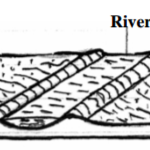KNEC KCSE Geography Paper 1 Question Paper / 2015 KCSE Tharaka South Joint Examination
2015 KCSE Tharaka South Joint Examination
Geography Paper 1
SECTION A (25 Marks)
Answer all questions in section A.
a) Study the world map below answer the questions that follow:
Name the fold mountain found in the area marked A, B and C. 3mks
b) Give two negative effects of faulting. 2mks
5 marks
a) Name three transitional zones of the atmosphere. 3mks
b) Give three reasons why cloud concentration is higher in the troposphere. 3mks
6 marks
The table be3low represent temperature and rainfall for two stations X and . Study them and answer the questions that follow.
a) i)Calculate the annual range of temperatures for station x and Y. 2mks
ii)Calculate the annual rainfall for station. 1mks
b)Describe the characteristics of rainfall for station X. 2mks
5 marks
a) What is an avalanche? 2mks
b) Identify three factors that influence the rate at which materials move down a slope. 3mks
5 marks
The figure below shows a feature formed in a glaciated landscape. Use it to answer the questions that follow.
a) Identify the feature. 1mks
b) Describe how the above feature is formed. 4mks
5 marks
SECTION B (75 Marks)
Answer question 6 and any other two questions in this section
Study the map of Karatina sheet 121/3 provided and answer the questions that follow.
a) i) Give the magnetic variation of the area shown on the map. 1mks
ii) Give two methods used in the map tract to represent relief. 2mks
iii) What is the six figure reference of the air photo principle point (21() in the North west part of the area covered by the map. 2mks
iv) What is the bearing of the water reservoir near Kiamucheru grid square 9054 from the junction where road D451 and
E1706 meet grid reference 860554. 3mks
b) Describe the drainage of the area covered by the map. 4mks
c) Draw a square measuring 7cm by 7cm to trepresent the area enclosed by eastings 81-88 and Northings 45-52.
2mks
On your square mark and name the following:
-A forest 1mk
-A power 1mk
– River Sagana 1mk
d)Citing evidence from the map, explain two factors that have attracted high settlement in the area covered by the extract.4mks
e) Students from a school near Mt. Kenya forest are planning to carry out a field study in the area covered in the map.
i) Name two types of field work they may consider carrying out. 2mks
ii) What factors are likely to disrupt the working schedule. 3mks
5 marks
The diagram below shows some surface features in a karst region. Use it to answer question (a)
a) Name the features marked P, Q and R. 3mks
b) Outline three factors that influence the development of karst scenery. 3mks
c) Using suitable diagrams, describe how the following features which are found in limestone areas are formed.
i) A shallow hole 5mks
ii) A doline 5mks
d) Explain three ways in which limestone landscapes influence human activities. 6mks
e) Form four students of your school undertook field work on a karst landscape.
i) State two objectives of their study. 2mks
ii) Give one reason why they need to pre-visit the area. 1mk
25 marks
a) i) what is soil catena? 2mks
ii) Draw a well labeled diagram to show a well- developed soil profile. 5mks
iii)State three characteristics of the soil found in the arid region of Kenya. 3mks
b) Give three factors that determine soil colour. 3mks
c) Describe how laterization occurs. 6mks
d) Explain how the following farming practices affect soil.
i) Burning 2mks
ii) Continuous application of fertilizer on farm lands. 2mks
iii) Monoculture. 2mks
25 marks
a) i) Outline two factors that influence the development of drainage pattern. 2mks
ii) Give three features of a river in its old stage. 3mks
b) Briefly describe how the following factors influence river erosion.
i) Gradient and velocity. 2mks
ii) Nature and amount of the load. 2mks
iii)Nature of bedrock 2mks
b) The diagram below represents features of a river. Study it and answer the questions below.
i) Name the parts labeled E, F and G in the diagram. 3mks
ii) Give one type of the feature represented by the diagram. 1mks
iii)State three conditions necessary for the following of the features shown in the diagram. 3mks
d) Apart from providing water for domestic and industrial uses, highlight three other benefits of rivers in Kenya.3mks
e) Your class intends to conduct a field study on river deposition around your school.
i) Name one stage along the profile of a river where your study conducted. 1mk
ii) State two methods you would like to collect data during the study. 2mks
iii) Give one benefit of river deposition that you intend to verify during the study. 1mk
25 marks
a)Differentiate between magnitude and intensity of an earthquake. 2mks
b) i)List down three major earthquake zones of the world. 3mks
ii) Identify four natural causes of earthquake. 4mk
c) The diagram below represents the features produced by vulcanicity. Use it to answer the following questions.
i)Identify the features A, B and C . 3mks
ii) Describe how the above feature is formed. 5mks
d) You are to carry out a field study on vulcanicity around your school.
i) Identify three extrusive landforms you are likely to identify. 3mks
ii) State three methods you would use to collect the data. 3mks
iii) State two ways in which you would prepare for field study. 2mks
25 marks













